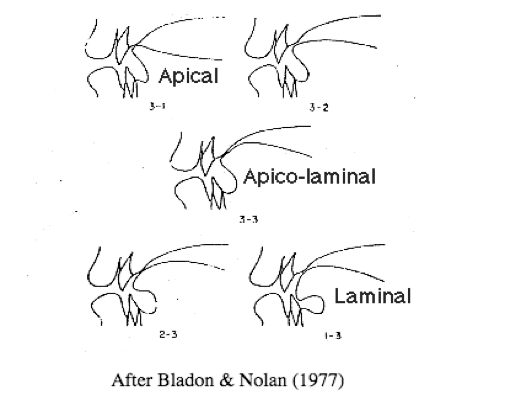Cards In This Set
| Front | Back |
|
What are semivowels? What do they look like on the spectrogram?
|
Semivowels/glides are really very short vowels which are acting phonologically as consonants.
[w]=[u]; [j] = [i]
• On the spectrogram glides have rapidly moving formants (depending on context) and less spectral energy than their corresponding vowels.
|
|
With your IPA chart, describe which vowels are high, low, rounded, unrounded front vowels?
|
 See image |
|
With your IPA chart, describe which vowels are high, low, rounded, unrounded central vowels?
|
 See image |
|
With your IPA chart, describe which vowels are high, low, rounded, unrounded back vowels?
|
 See image |
|
Length can be _______ or _________.
|
Length can be phonemic or phonetic:
– English has a phonemic or phonological length contrastwhich is manifest with distinct vowel quality (sometimes
called tense and lax) : eg. keep and kept, serene~serenity.
– English also has a phonetic length: eg. bet, bed.
|
|
Vowels followed by ____ consonants are ______ than those followed by ______ consonants.
|
Vowels followed by voiced consonants are longer than those followed by voiceless consonants.
• Canadian raising – long vowels have different quality before voiced and voiceless consonants. The vowel of knife is different
(raised) from that of knives
|
|
Vowels are most frequently _____.
|
Vowels are most frequently voiced but may sometimes be allo-phonically voiceless
– Japanese: hi vowels are voiceless between voiceless
consonants: su˳kiyaki, hi˳to
|
|
How can we increase the possible number of vowel and consonant sounds?
|
we can increase the possible number of
vowel and consonant sounds by the
addition or removal of other articulations
|
|
Back unroundeded vowels are _____ than front rounded vowels.
|
Back unrounded vowels less common than front rounded
vowels
|
|
When rounded, consonants are called ____.
|
Consonants when rounded are called labialized
– Symbol raised [w] eg.[pw, kw ] (Eg Chaha
– {gkr} 'be straight’ derived adjective : gʷǝkʷǝr 'straight'.
|
|
Vowels are most frequently ___ but may also be ___. When nasal, they are pronounced with ___ velum.
|
Vowels are most frequently oral but may also
be nasal- ie. pronounced with an open velum
– Many languages contrast nasal with oral vowels.
Eg. French, Portuguese
|
|
What happens when English vowels are nasalized?
|
Nasal airflow in French and English vowels goes all through the vowel for French nasal
vowels but partial for nasalised English vowels
– English vowels are nasalized by coarticulation
|
|
Coarticulation is a ___ effect rather than a ____ change.
|
coarticulation -- a phonetic
effect of a neighboring sound rather than a phonological
(feature) change
|
|
What consonants can be pronounced with nasalization?
|
Some consonants can be pronounced with
nasalization:
– approximants and fricatives bt not stops
|
|
Describe velarization.
|
Overlay of high back lax vowel articulation
Simultaneous with consonant articulation
Symbol: Either [ ɫ] or [dɤ ]
• Pharyngealization - overlay of pharyngeal
construction simultaneous with consonant articulation
Symbol: [dʕ ]
|



